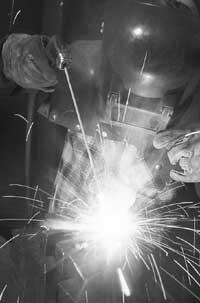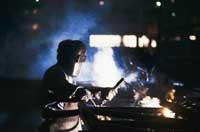International Tube Association awards Jon Etxeberria Uranga, CEIT researcher
2002/04/04 Andonegi Beristain, Garazi - Elhuyar Zientziaren Komunikazioa
Did you expect to receive this award?

- The truth is that when you present a work in a congress you do not think in any case that you are going to receive a prize; in addition, in some congresses these prizes do not exist. When we presented the article at the Congress of Bilbao and made the inscription, a section asked whether or not to register for the prize. We realized that the work we presented in October last year has been the winner. The surprise has been enormous; in addition, some of the congresses organized by the organization are repeated year after year, others are repeated weekly and the work we presented was for a biannual congress. When we presented the work we did not know the frequency of the congress and when it was known that it was done every two years we rejoiced much more.
What is the importance of the International Tube Associattion in the world of tubes?
- We met the organization of the hand of a company that manufactures tubes, Tubacex. They told us that this entity should organize a congress in Bilbao in October 2001 and encouraged us to present their work with them. Then I collected information about the organization and saw that the International Tube Association is an organization that brings together major tube manufacturers worldwide.
When did the project you have submitted begin and with what objectives?
- The project began in 1997 with the grant of the Basque Government and was a coordinated project between companies and technology centers. In the project were the manufacturer of tubes Tubacex, the manufacturer of goods Babcock Wilcox and the owner of the thermal power stations in which the Iberdrola tubes were to be installed.
Tubacex had conducted previous studies on bimetallic tubes but without additional follow-up. Subsequently, in order to remove new products, the aim was to promote the investigation of these bimetallic tubes, thus initiating the project. With the bimetallic tubes it was intended to unify the properties of both materials, that is, to take advantage of the high mechanical resistance that can provide a steel with its anticorrosive properties. In this way, the properties of both metals are combined in a single tube.
What were the main steps taken in the research?
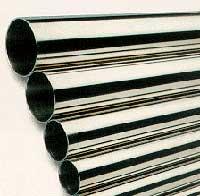
- The study had to study the possibility of simultaneously extruding both materials and the viability of their manufacture. Subsequently, laboratory tests measured the parameters of optimization of the manufacture and it was verified that the properties could be improved by thermal treatments.
According to the parameters established in the laboratory, Tubacex tubes were manufactured and subsequently placed in an installation of Babcock Wilcox. In it were carried out pipe bending tests, welding of bimetallic tubes with other monolithic tubes (monomaterials), etc. In this way, all the steps to follow in the process of replacing old pipes with new ones in an installation were analyzed.
Once the process was completed, the tube properties were measured again in the laboratory to check whether or not there were changes and it was found that they did not occur. Finally, these curved tubes and soldiers were taken to an Iberdrola plant, where they have been operating for more than 10,000 hours.
What characteristics do you find in bimetallic tubes?
- We usually talk about steels and depending on the usual applications to be used, a high mechanical resistance and corrosion resistance is required. The high mechanical resistance allows the tube to not break before efforts, even if the material is at high temperature. In addition, facing the environment in which they are going to work, corrosion resistance is an essential property. You can make stainless steel tubes to combat corrosion, but they are usually weak from the point of view of mechanical resistance. In addition, stainless steel is expensive. However, if the interior of the pipes is built with a cheaper but resistant steel and then a stainless steel outer layer is placed, it is possible to unify both properties at a competitive price.
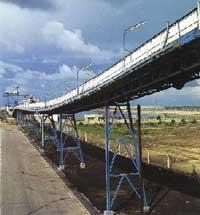
In the case of thermal power plants, for example, pipes must carry water vapor that is heated externally. The transmission of this heat also requires a good thermal conductivity, which in the case of stainless steel is usually low. Therefore, the formation of the core with a more normal steel allows to increase the conductivity and achieve a more suitable heat transfer for water vapor.
What physical characteristics of the tubes have you worked? The properties of bimetallic tubes are modified in terms of size, thickness, internal width, etc. Do you agree?
- The tubes we manufactured were the size of conventional steel tubes. They had the same diameter, but what was changed was the thickness of the tube walls. This thickness is normally 6 mm and we use two materials to give it that thickness: Common steel 4.5 mm and stainless steel 1.5 mm. On many occasions you can play with these thicknesses depending on the characteristics you want, making a thicker layer. The stainless steel layer used was 1.5 mm, thicker than necessary, but it was tried to seek safety from corrosion.
For whom are the results of this research, for which industrial sector?
- The project has three applications: thermal power plants, waste incineration plants and coal gasification plants. In the three, a different tube composition was used for the required characteristics. For example, in the waste incinerator the corrosion caused by the environment was greater than on other occasions and stainless steel of higher quality was used.
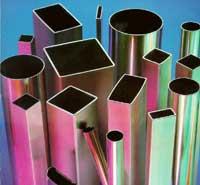
There are other applications, such as bimetallic tubes used for oil exploitation, but in these cases stainless steel is placed inside and the common steel on the outside. In the case of oil, the risk of corrosion is provided by a material that passes inside and not outside.
What is the main disadvantage of a bimetallic tube? Or are all benefits?
- The main disadvantage can be the price, since the process of manufacturing the bimetallic tubes is somewhat more complex. The process, the extrusion itself, is very similar to when performing a conventional tube or a bimetallic tube, but the assembly between the inner layer and the outer layer is more difficult and there may be problems, among others, because when drilling the inner material you can remove the outer layer. However, the price is the main problem compared to monolithic material tubes, so it is necessary to look for more specialized applications for these bimetallic tubes.
What has been the main novelty you have offered?
- The main novelty has been the review of the actual operation of the bimetallic tubes. Already there were tests carried out in Tubacex, even laboratory parametrizations, but the previous investigations did not know how the processing of the tubes should be, nor what would be their behavior at work. The work carried out by us, in addition to analyzing all of them, has investigated bimetallic compositions not previously analyzed. In addition, we have shown that stainless steel can be placed on the outside.
What other techniques exist for the manufacture of these bimetallic tubes?

- There are two ways, one of coextrusion and another of application of coatings by sprays or projections. These last techniques present remarkable difficulties, since it must be worked with long pipes, since the outer layer must have a certain thickness and there is no chemical union between both layers. This can make the upper layer rise and even fall. However, in coextrusion a chemical bond is produced, that is, metallurgical, between both metals, so it functions as a single material.
Do we therefore expect that these bimetallic tubes will be extended in the future in the market?
- Well, the reliability of the tubes was demonstrated long ago, but it seems that it is not very clear if there is market for those bimetallic tubes. Tubacex patent, etc. Therefore, we asked them if they intended to start manufacturing them, but since the market and demand are not safe, they have not yet opened the way for it.
The only ones that have been carried out are currently in the facilities of the two Iberdrola power stations, which are periodically reviewed. These studies show that everything goes perfectly, so we hope that in the future these tubes will be used.

Gai honi buruzko eduki gehiago
Elhuyarrek garatutako teknologia




